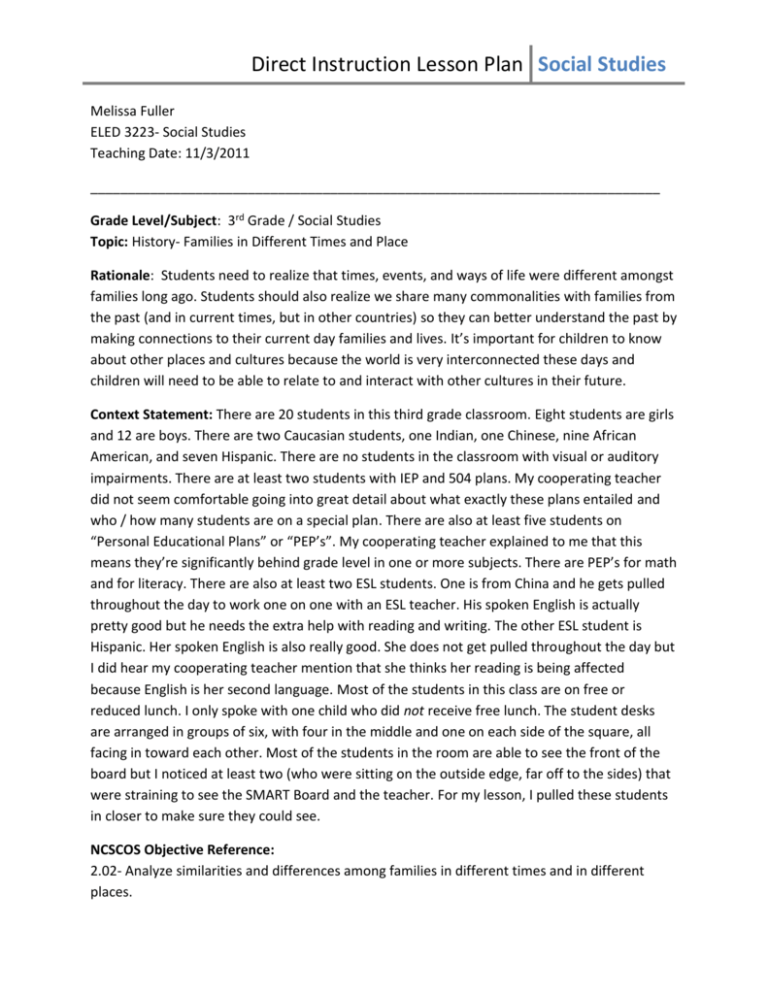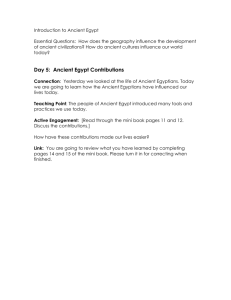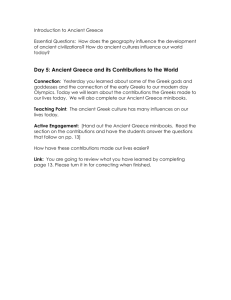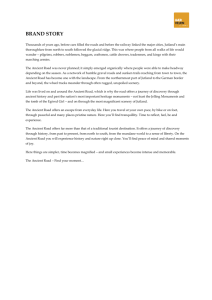Direct Instruction Lesson Plan
advertisement

Direct Instruction Lesson Plan Social Studies Melissa Fuller ELED 3223- Social Studies Teaching Date: 11/3/2011 ____________________________________________________________________________ Grade Level/Subject: 3rd Grade / Social Studies Topic: History- Families in Different Times and Place Rationale: Students need to realize that times, events, and ways of life were different amongst families long ago. Students should also realize we share many commonalities with families from the past (and in current times, but in other countries) so they can better understand the past by making connections to their current day families and lives. It’s important for children to know about other places and cultures because the world is very interconnected these days and children will need to be able to relate to and interact with other cultures in their future. Context Statement: There are 20 students in this third grade classroom. Eight students are girls and 12 are boys. There are two Caucasian students, one Indian, one Chinese, nine African American, and seven Hispanic. There are no students in the classroom with visual or auditory impairments. There are at least two students with IEP and 504 plans. My cooperating teacher did not seem comfortable going into great detail about what exactly these plans entailed and who / how many students are on a special plan. There are also at least five students on “Personal Educational Plans” or “PEP’s”. My cooperating teacher explained to me that this means they’re significantly behind grade level in one or more subjects. There are PEP’s for math and for literacy. There are also at least two ESL students. One is from China and he gets pulled throughout the day to work one on one with an ESL teacher. His spoken English is actually pretty good but he needs the extra help with reading and writing. The other ESL student is Hispanic. Her spoken English is also really good. She does not get pulled throughout the day but I did hear my cooperating teacher mention that she thinks her reading is being affected because English is her second language. Most of the students in this class are on free or reduced lunch. I only spoke with one child who did not receive free lunch. The student desks are arranged in groups of six, with four in the middle and one on each side of the square, all facing in toward each other. Most of the students in the room are able to see the front of the board but I noticed at least two (who were sitting on the outside edge, far off to the sides) that were straining to see the SMART Board and the teacher. For my lesson, I pulled these students in closer to make sure they could see. NCSCOS Objective Reference: 2.02- Analyze similarities and differences among families in different times and in different places. Direct Instruction Lesson Plan Social Studies Instructional Objective: Students will be able to list differences, similarities and characteristics of Ancient Mesopotamia, Ancient Greece, and Ancient Rome on a worksheet. Specifically, they will need to know the following: 1. What is the name of an early community that began in Mesopotamia? 2. What is one way in which the roles of boys in ancient Sumer were different from the roles of girls? 3. What 3 subjects did boys in both ancients Athens and ancient Sumer study? 4. What is the name of the ancient community in which wealthy men worked in banking or government? 5. Why is it important to learn about people who lived long ago? 6. How is your life DIFFERENT from the lives of boys and girls from ancient times? Students will be able to correctly answer the questions on the worksheet. For #1, there is only one right answer. If they put the correct community name, they get the question right. (1 point) For #2, there are a few correct answers, but as long as they have one of the mentioned reasons (jobs, education, lifestyle-oriented) they get the question correct. (1 point) For #3, there are only three possible answers for the three subjects. They will get one point per correct subject. (3 points) For #4, there is only one correct answer and this is not an open-ended question. Anything else is wrong. (1 point) For #5, there is a lot of creative freedom here. Some specific reasons are mentioned throughout this lesson (especially at the beginning) but the students are free to branch out here. They will not find this answer in the book. One point for a complete sentence and one point for a plausible answer. (2 points) For #6, there is a lot of creative freedom here also. Throughout this lesson, I talked to the students about some of the differences and similarities but everyone will have a different answer for this one. One point for a complete sentence and one point for a plausible answer. (2 points) Prerequisites: Students probably know that all families are unique. Students probably have a slight understanding of what the “past” is, in terms of “a very long time ago” or “yesterday.” Students might have misconceptions around the concept, like possibly thinking that their family and home life is “normal” and they may even assume their way is how every family out there operates. They also might think that things have stayed relatively the same over time. The students in this class are aware that children in different countries have very different norms Direct Instruction Lesson Plan Social Studies than they do because their teacher shows them this website called “Around the World” every morning. “Around the World” is where they look at the day in the life of a student in another country so they do at least know that there are other countries and other cultures around the world. I also bring up some reading terms throughout the lesson. The students have a basic understanding of story elements and know about story schema, main idea, supporting details, sequence, etc. Materials/Resources: *Student Social Studies books *Social Studies journals (spiral bound notebook) *Pencils *Student worksheet *Social Studies Teacher’s Edition book *I modified this lesson using the Socials Studies Teacher’s Edition book. At the end of this lesson, I have included images of the pages of this book, the student work book and of the student worksheet. Content and Strategies Focus/Review: “Today we’re going to have a fun social studies lesson and we’ll be talking about different places in ancient times and in different places around the world! Who can tell me something you have learned this year about someone or somewhere around the world? Think about the information Ms. Mack shares with you every day and what you’ve learned about students like you…” Call on a few different students and see what they come up with. Their regular teacher always stresses that students around the world are their competition for the 21st century, so I will connect to that prior knowledge also and tell students we will be building upon that today. Objective (as stated for students): “You will name differences and similarities between families and happenings in ancient places and compare similarities and differences to current day times. At the end of this lesson, you will be completing a worksheet that asks questions about what you learned so make sure you’re paying close attention! Some of the things you need to listen for and know are community names, differences in gender roles, and subjects students studied. I will also ask you some things that you’ll have to think about because the answers are not in the book. As we go through this lesson, make sure you’re thinking about why it’s important to learn about people from a long time ago and how your life is different than the lives of boys and girls in ancient times.” Teacher Input: Introduce new vocabulary words before delving into the lesson. “One of the words we’re going to hear a lot today is ancient… as in ‘place in ancient times’…. Who can tell Direct Instruction Lesson Plan Social Studies me what it means when something is ancient?” If a lot of students think they know, have them share quietly with their table groups. See if any students know the correct definition and if they don’t, explain that ancient refers to the earliest time periods in civilization and also to a really long time ago. Give examples of things that would seem “ancient” to them, such as their great grandmother’s wedding dress, or Babe Ruth’s baseball glove. Also give non examples such as, “So that Halloween candy you may have gotten a couple days ago, is that ancient? How about your school? Would this school be considered ancient?” Also define and explain civilization. Have students use their social studies journals to write down the new vocabulary words and the corresponding definitions. Once they have the word and the definition written down, encourage students to use their newly learned vocabulary words to write their own unique complete sentence underneath the word. In addition to creating a unique sentence, students can also draw a picture of their interpretation of the word and what it means to them. Show pictures of Mesopotamia, Greece, and Rome on Google maps to compare and show relation to how incredibly far away they are from Charlotte, the United States and from each other. Mention you would need to cross an entire ocean to get to the places we’re talking about in this lesson. Guided Practice: Have students follow along in their social studies books as I go through the characteristics of the different places by reading through the passages. I will read some of the text aloud and tell students to be looking for important information and main ideas. They have been working with the concepts of “Main Ideas” and “Supporting Details” for reading so this will reinforce that prior knowledge. I will ask for volunteers to read certain sections or sentences. At times, I will have the whole class read the sections allowed. I will pay special attention to their pausing at commas and periods, voice tone and voice emphasis, and overall fluency. The students in this class have been working on fluency in reading so they know how they should and should not be reading aloud. As we read, we will relate to and/or talk about how different the three places are in comparison to where we live. I will ask about sequence (another concept they’ve been discussing in reading) and have them tell me what they already know about story sequence and how they can relate that to social studies. Encourage them to make connections by thinking about the order that things happened in ancient times, and even in our passage reading. Ask questions to have the students relate the different places we talk about back to their families and the current day times. “How were these ancient places different from each other? How were they different to our world today? How were they all similar to each other? Did they have anything in common?” We will do a lot of comparing and contrasting. Direct Instruction Lesson Plan Social Studies CFU: I will use the “thumbs up/thumbs down/thumbs sideways” method and ask students if they are comfortable with what we have already covered (this was really effective!). I will do this throughout the lesson and at the end of the passage on each of the three places. Independent Practice: Give each student time to independently complete their worksheet. Closure: Have the students do a reflection on what they learned in their social studies notebooks. See the PID section (#3) for more information and variations of this. Assessment: See the “Instructional Objective” section for the specific questions on the worksheet and how points per question will be scored. Summative- I will gauge learning formally by looking at their worksheets. This worksheet will be out of 10 points total. The breakdown is as follows: 10-8 points- Student grasped concept and understood assignment 7-5 points- Student somewhat understand the concept and assignment, but might need a little extra work. 4 points and under- Student did not at all understand concepts and definitely needs further instruction. Formative- I will assess student learning informally by doing the “thumbs up/thumbs sideways/thumbs down” method at a couple points during the lesson and through collecting data by asking questions. Plans for Individual Differences: 1. For the students who do not give me a thumbs up while I’m gauging understanding, AND for the lower level students (the ones with IEP’s, PEP’s, etc.) I will pull them to the side and work with them individually or as a small group as the class completes their worksheets. 2. For early finishers, I will have them take their reading notebooks out and think of more sentences using the new vocabulary words they just used. 3. In the “Closure” section, students are asked to do a reflection on the lesson in their social studies notebooks. For the Verbal/Linguistic learners, they could write a journal entry about what they learned OR write a letter to a student in ancient times. For the Bodily/Kinesthetic learners, they could have the option to do a skip and act like a person from one of the ancient places. For any Musical/Rhythmic learners in the class, they could make up a song to present to the class. **This lesson plan was added to, modified, altered, and reconstructed by Melissa Fuller but some of the ideas and a lot of the content came from the Social Studies Teacher’s Edition that they use at the school. Copies of all resources used are included below: Direct Instruction Lesson Plan Social Studies Teacher’s Edition: Direct Instruction Lesson Plan Social Studies Direct Instruction Lesson Plan Social Studies Student Edition: Direct Instruction Lesson Plan Social Studies Student Worksheet:








